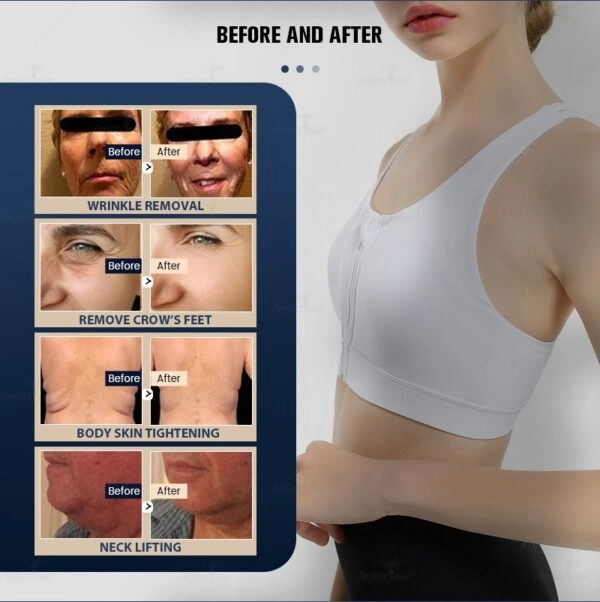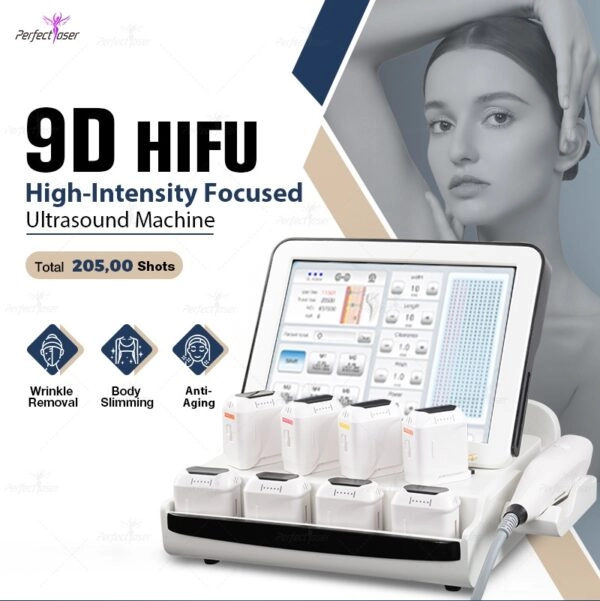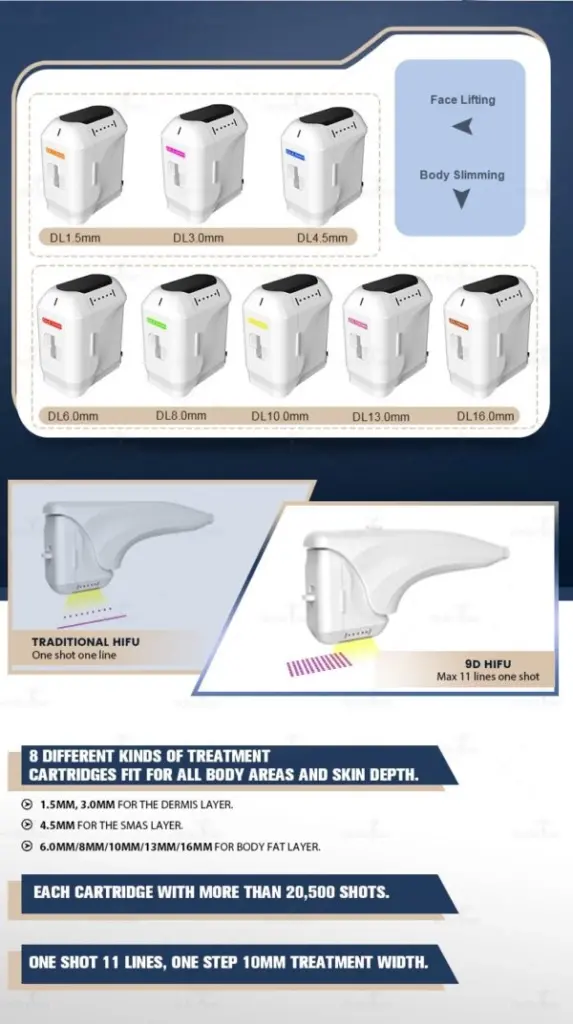
High-Intensity Focused Ultrasound, or HIFU, is a way to get cosmetic results without surgery. Lots of people choose it to help tighten up their skin and smooth out wrinkles.
But here’s something clinics and patients really need to keep in mind: those HIFU cartridges cost money to replace. Figuring out how much it costs to keep the machine running, especially buying new cartridges, is super important.
Because how much those cartridges cost, and how long they actually last? That makes a huge difference to what the treatments end up costing everyone. It directly hits the budget.
What is HIFU and How Does It Function?
HIFU uses targeted ultrasound energy. It reaches skin layers below the surface. This energy heats the tissue quickly. It boosts collagen production. The result is firmer, younger-looking skin. Unlike surgery, HIFU is non-invasive. It requires no recovery time. Its accuracy lets practitioners focus on specific areas without harming nearby tissues.
HIFU devices depend on cartridges. These emit ultrasound energy. Cartridges deliver a set number of pulses or shots. They need replacement after reaching this limit. The cartridge lifespan depends on usage and shot capacity. Clinics must track their performance carefully.
Factors Affecting HIFU Cartridge Replacement Cost
Material and Manufacturing Quality
The quality of materials in HIFU cartridges impacts their price. Cartridges made from top-grade materials last longer. They provide steady performance. However, these materials cost more. Clinics must balance the benefits of durable cartridges with their budget limits.
Manufacturing methods also influence costs. Advanced techniques improve precision and durability. They raise production costs. But they create better cartridges. Clinics should decide if higher initial costs lead to savings over time with fewer replacements.
Brand and Device Compatibility
The HIFU device brand affects cartridge costs. Well-known brands charge more for their cartridges. They are trusted for reliability and results. Also, unique designs mean only specific cartridges work with certain devices. This limits cheaper options for clinics.
Using third-party cartridges can cause issues. They may seem affordable at first. But they could harm the device or reduce performance. This raises repair costs in the long run.
Availability of Aftermarket Options
Aftermarket cartridges offer a chance to save money. Third-party makers often sell compatible cartridges at lower prices than original manufacturers. But clinics must be careful. Quality varies widely.
Some aftermarket products match or beat original standards. Others may lower treatment of HIFU quality or harm the device. Clinics should research third-party options thoroughly. This ensures they don’t affect patient results or equipment performance.
By understanding material quality, brand compatibility, and aftermarket options, clinics can manage cartridge costs and lifespans. This improves financial efficiency and treatment quality.

The Lifespan of HIFU Cartridges
Average Usage Duration of a Cartridge
A HIFU cartridge’s lifespan depends on its shot capacity. This usually ranges from 10,000 to 20,000 shots. It varies by model and maker. Each cartridge delivers precise energy for effective treatments. This capacity determines how long it lasts before replacement. Clinics track shots to ensure effectiveness.
Actual lifespan may differ. Factors like treatment intensity and frequency play a role. High-intensity treatments shorten cartridge life compared to milder ones. Knowing these factors helps clinics manage inventory and cut costs.
Key Factors That Affect Cartridge Lifespan
Frequency of Treatments
How often a HIFU device is used affects cartridge lifespan. Clinics with many daily treatments use up cartridges faster. Those with fewer patients deplete them slower. Frequent use can wear out cartridge parts. This may reduce efficiency over time.
Planning treatments based on patient demand can balance cartridge use. It extends their lifespan. Clinics expecting heavy use should choose cartridges with higher shot capacities. This offers better value long-term.
Intensity Settings During Procedures
The intensity level during HIFU treatments impacts cartridge life. Higher settings use more energy. This depletes shot capacity faster. Lower settings preserve the cartridge longer.
Practitioners should assess each patient’s needs. They must tailor treatments for best results without overworking the device. Proper training and following maker guidelines maintain treatment quality and cartridge durability.
Balancing Cost and Lifespan for Better Budgeting
Calculating the Cost Per Treatment Session
Clinics must calculate treatment costs to manage budgets. Divide the cartridge cost by its shot capacity. This gives the cost per shot. For example, a $1,000 cartridge with 10,000 shots costs $0.10 per shot.
This helps clinics set fair prices while staying profitable. Tracking usage patterns can also find ways to save without lowering care quality.
Strategies to Extend Cartridge Lifespan
Proper Maintenance Practices
Good maintenance extends cartridge life. Regular cleaning and checks keep the device running smoothly. They prevent extra strain on cartridges. Following the maker’s maintenance schedule spots issues early. This cuts downtime and repair costs.
Using compatible parts and avoiding fake ones boosts performance. It also prolongs cartridge life. Clinics should buy quality equipment from trusted suppliers to avoid risks from poor parts.
Avoiding Overuse or Misuse
Overusing or misusing cartridges shortens their life. It can also harm treatment results. Practitioners must stick to shot limits. They should avoid going over during procedures. Using wrong intensity settings or ignoring protocols causes early wear.
Training staff on proper device use prevents misuse. It ensures steady performance. Clinics should set clear rules for tracking cartridge use and replacing them when needed. This maintains top results.

HIFU technology offers many benefits for non-surgical cosmetic treatments. But understanding cartridge replacement costs and lifespans is key for budgeting. By considering material quality, brand compatibility, treatment frequency, and maintenance, clinics can maximize their HIFU device investment. They can also deliver high-quality care.
For reliable solutions at good prices, Perfectlaser offers a wide range of HIFU devices and cartridges. They are built for durability and excellent performance. Explore Perfectlaser products today to boost your clinic’s capabilities while keeping costs in check.
FAQ
Q: What is a HIFU cartridge, and why does it need replacing?
A: A HIFU cartridge is a key part inside the HIFU machine. It sends out focused ultrasound energy to treat the skin. Think of it like a fuel tank – each cartridge only has a certain number of “shots” or pulses it can deliver. Usually, that’s around 10,000 to 20,000 shots. Once it uses up all those shots, the cartridge is empty. You have to swap it out for a new one. If you don’t, the machine just won’t work right for treatments anymore.
Q: How long does a HIFU cartridge last?
A: How long a cartridge lasts boils down to how many shots it holds. That number is typically between 10,000 and 20,000. This could mean it lasts you months, or maybe even years. The exact lifespan? That totally depends on you. How often are you using the machine? Also, how intense are the treatments you’re giving? If you’re using it constantly or cranking up the power high every time, that really cuts down its life.


